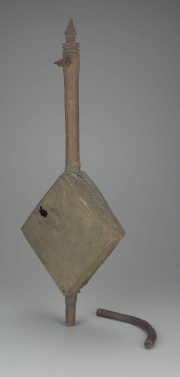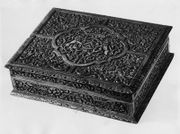Difference between revisions of "Olive"
Jump to navigation
Jump to search
| (One intermediate revision by the same user not shown) | |||
| Line 30: | Line 30: | ||
* Virginia Tech Dendrology website at www.fw.vt.edu/dendro/dendrology/main.htm (Accessed Dec. 9, 2005) | * Virginia Tech Dendrology website at www.fw.vt.edu/dendro/dendrology/main.htm (Accessed Dec. 9, 2005) | ||
* R.Gale, P.Gasson, N.Hepper, G.Killen, "Wood" , ''Ancient Egyptian Materials and Technology'', Cambridge University Press, Cambridge, p. 334-371., 2000 | * R.Gale, P.Gasson, N.Hepper, G.Killen, "Wood" , ''Ancient Egyptian Materials and Technology'', Cambridge University Press, Cambridge, p. 334-371., 2000 | ||
| − | * Wikipedia: | + | * Wikipedia: [https://en.wikipedia.org/wiki/Olive Olive] (Accessed Dec. 9, 2005 and October 2024) |
* R. J. Gettens, G.L. Stout, ''Painting Materials, A Short Encyclopaedia'', Dover Publications, New York, 1966 | * R. J. Gettens, G.L. Stout, ''Painting Materials, A Short Encyclopaedia'', Dover Publications, New York, 1966 | ||
* G.S.Brady, ''Materials Handbook'', McGraw-Hill Book Co., New York, 1971 Comment: p. 593, 560 | * G.S.Brady, ''Materials Handbook'', McGraw-Hill Book Co., New York, 1971 Comment: p. 593, 560 | ||
| Line 40: | Line 40: | ||
| − | [[Category:Materials database | + | [[Category:Materials database]] |
Latest revision as of 11:56, 18 November 2024
Description
A small, evergreen tree, Olea europaea, native to the Mediterranean region. The small tree is grown commercially for its fruits and oil. The dense, durable wood of the olive tree is yellowish to light brown with a greenish tinge and a straight, close grain. Some older trees produce wood with decorative figuring. Olive wood polishes to a smooth glossy surface. It is used for furniture, inlay, carving, turnery, and small decorative items.
Synonyms and Related Terms
Olea europaea; Olivenbaum (Deut.); Echter Ölbaum (Deut.); olivo (Esp., It.); olivier (Fr.); olijfboom(Ned.); oliventre (Nor.); oliwka (Pol.); oliveira (Port.); olivträd (Sven.); olive-wood; olive wood; olivewood
Physical and Chemical Properties
- Shrub or small tree to 8 m high.
- Bark=light gray-brown; smooth aging to gnarled and bumpy.
- Leaves=simple, opposite, oblong, pointed (4-10 cm long).
- Fruit=oblong green drupe up to 3 cm turning purple or black when ripe in winter.
- Density = 50-60 ppcf
Additional Images
Resources and Citations
- F. H. Titmuss, Commercial Timbers of the World, The Technical Press Ltd., London, 1965
- Virginia Tech Dendrology website at www.fw.vt.edu/dendro/dendrology/main.htm (Accessed Dec. 9, 2005)
- R.Gale, P.Gasson, N.Hepper, G.Killen, "Wood" , Ancient Egyptian Materials and Technology, Cambridge University Press, Cambridge, p. 334-371., 2000
- Wikipedia: Olive (Accessed Dec. 9, 2005 and October 2024)
- R. J. Gettens, G.L. Stout, Painting Materials, A Short Encyclopaedia, Dover Publications, New York, 1966
- G.S.Brady, Materials Handbook, McGraw-Hill Book Co., New York, 1971 Comment: p. 593, 560
- Dictionary of Building Preservation, Ward Bucher, ed., John Wiley & Sons, Inc., New York City, 1996
- The Merck Index, Martha Windholz (ed.), Merck Research Labs, Rahway NJ, 10th edition, 1983 Comment: Entry 6973
- The American Heritage Dictionary or Encarta, via Microsoft Bookshelf 98, Microsoft Corp., 1998
- George Savage, Art and Antique Restorer's Handbook, Rockliff Publishing Corp, London, 1954




